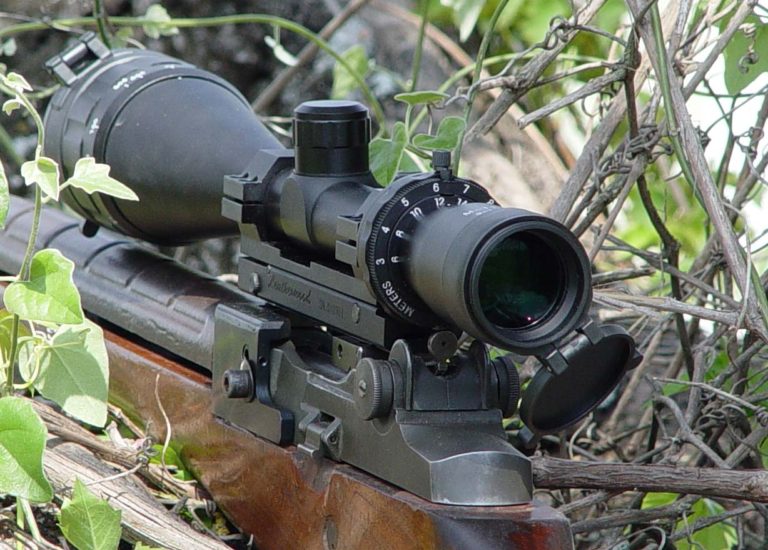
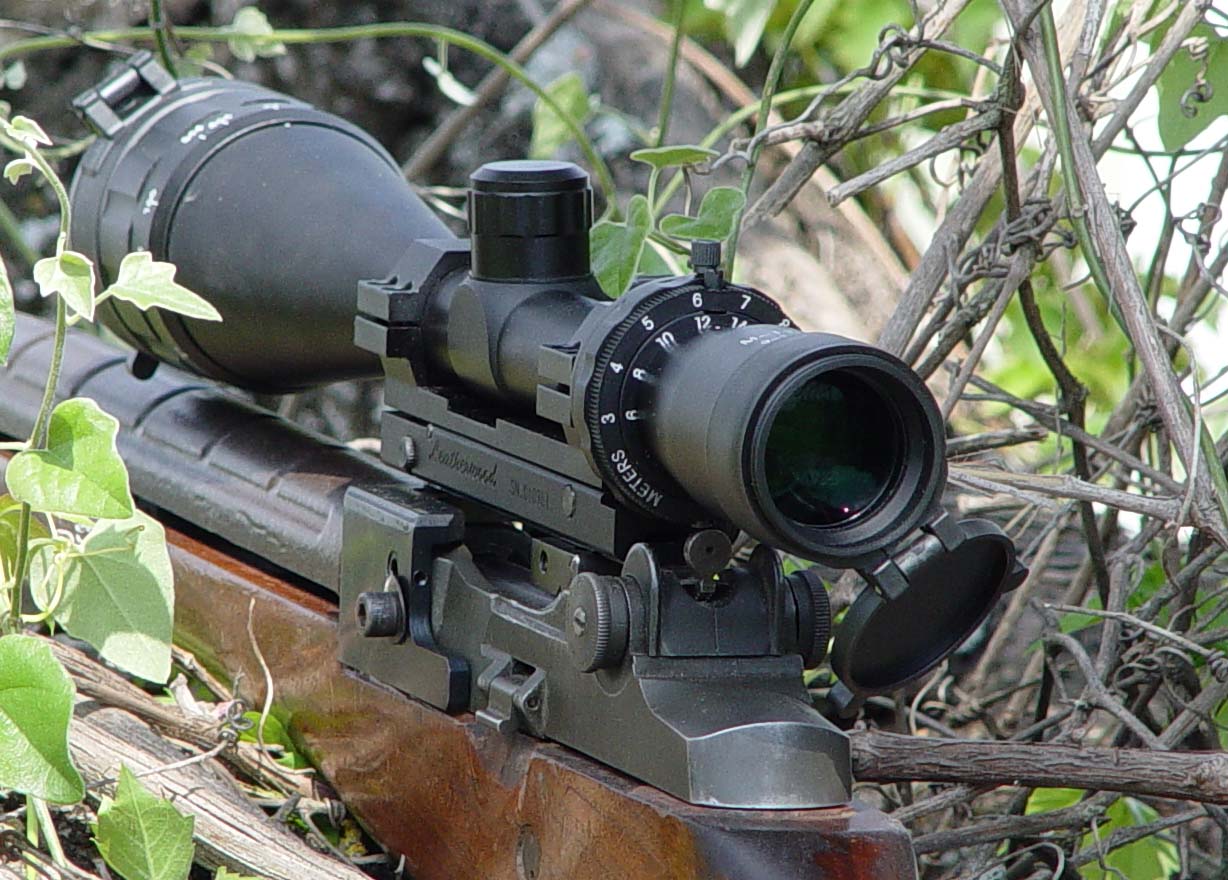
The Leatherwood ART scope allows you to frame, aim and shoot — to 1,000 meters and beyond. Is the ART M1000 Pro the simplest sniper scope ever devised?
“A child of five would understand this. Send someone to fetch a child of five,” said Groucho Marx, in one of his classic spoofs. My first experience with a long-range sniper scope was a lot like that — like something out of a Marx Brothers routine. In fact, I was completely out of my element when it came to using the thing. However, that is not so with the Leatherwood ART scope.
Tactical sniper scopes relying upon ultra-fine turret adjustments can confuse even the most level-headed rifleman in the heat of battle. Sure, ¼ MOA turrets are precise, but can make field shooting a complex and time-consuming affair.
History of the Leatherwood ART Scope
2nd Lieutenant James Leatherwood (U.S. Army) understood this problem. Back in the 1960's, before he entered the Vietnam War, Leatherwood worked on a scope called the ART (Automatic Ranging and Trajectory) to simplify and bring together range finding and bullet drop compensation. As a matter of fact, it came just in time as the U.S. military found itself losing servicemen to Viet Cong snipers who had the home field advantage in terrain that was, to say the least, difficult.
Under stressful conditions like those, it needed to be simpler, faster. One didn't have time to fiddle around with one's sniper rifle.
The result was that the Leatherwood ART scope — and later the ART II — solved the bullet drop and ranging problem for the military. Consequentyly, the Army installed the scope on M14/M21s, and U.S. snipers began to gain advantage on the battlefield. Indeed, they were unorthodox and they were deadly.
How Does the Leatherwood ART M1000 Work?
The M1000 auto ranging scope operated by combining a variable power zoom ring locked to a caliber-specific cam and hinged base. There is a rectangular bracket representing 1 meter (with 18-inch or ½-meter subtends) surrounding the crosshair. So, the power ring and adjustable cam are synced to the scope base, which raises and lowers compensating for bullet drop. In addition, you can fine-tune the cam based on changes in elevation or temperature.
It sounds complicated but it takes all the computations necessary for range acquisition and bullet drop compensation off the shooter’s plate and does them automatically. And best of all, your eye never has to leave the scope: You can literally engage any number of targets from close up to 1,000 yards (1,200 yards with the M-1200 version) with a simple turn of the knob.
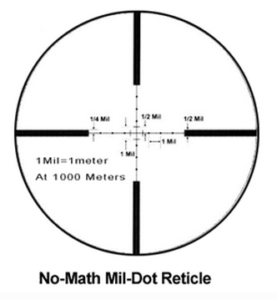
You “frame” an object of known measurement using the power ring in the bracket found in the scope’s reticle. The scope base adjusts appropriately. Aim. And shoot.
Easiest Auto Ranging Scope Ever
Furthermore, you don’t really need to know what range the target is; all the computations are internal.
However, the one exception to that is for wind compensation or shooting at angles. For these more advanced requirements, after you’ve bracketed the target, the range is spelled out on the near side of the zoom ring.
Once you know that, you can either use the turret to make an MOA-based wind adjustment, or — since you hold crosshairs dead-on with this system, a distinct advantage — you hold over right or left using a Mil holdover.
The Best Scope for the M14 or M1A?
The auto-ranging scopes were so effective in Vietnam, they are the only optic from that era still in active duty today. In fact, the U.S. Army’s FM 23-10 Sniper Training Manual still covers operation and maintenance of the scope. Today, a firm called Iron Sight, Inc. builds and repairs the military ARTII.
The Leatherwood ART M1000 is a civilian version of the concept, produced by Leatherwood Hi-Lux, under the direction of Leatherwood’s son Corbett Leatherwood. It is nearly identical to the military version save for the fact that it sits slightly higher than the military ARTII.
Other differences include the cam being adjustable for cartridges ranging from the 17 Remington to the .50 BMG. Moreover, its turrets are unique, too, with the ability to save five different zeroes for a multitude of rounds (target and hunting ammo, for example). It’s considerably more affordable, with an MSRP of less than $500 (used ARTIIs are fetching $1,000-$1,500).
The M1000 optic is 2.5-10 X 44 mm, while the M-1200 is a 6-24 X 50 mm scope. Both have 1-inch tubes.
The Best Automatic Ranging Scope?
In addition to its auto ranging features, I’m impressed with the quality of construction given the price point. While the first generation reportedly had a rocky start, these newer generation scopes have gotten better and now enjoy a very good reputation.
The scope is entirely mechanical (as opposed to relying on electronics) — and can be calibrated for just about any cartridge. You get a lot of bang for your buck.
With an interesting military history, and track record of success in the field, plus ease-of-use for today’s recreational long-range shooters, the ART might be the most interesting scope I have ever reviewed.
What's more, it’s the ideal designated marksmen rifle scope. Leatherwood sees it as a way to give new folks instant success and confidence in the long-range shooting game. Indeed, it may be the ideal auto adjusting rifle scope on the market.
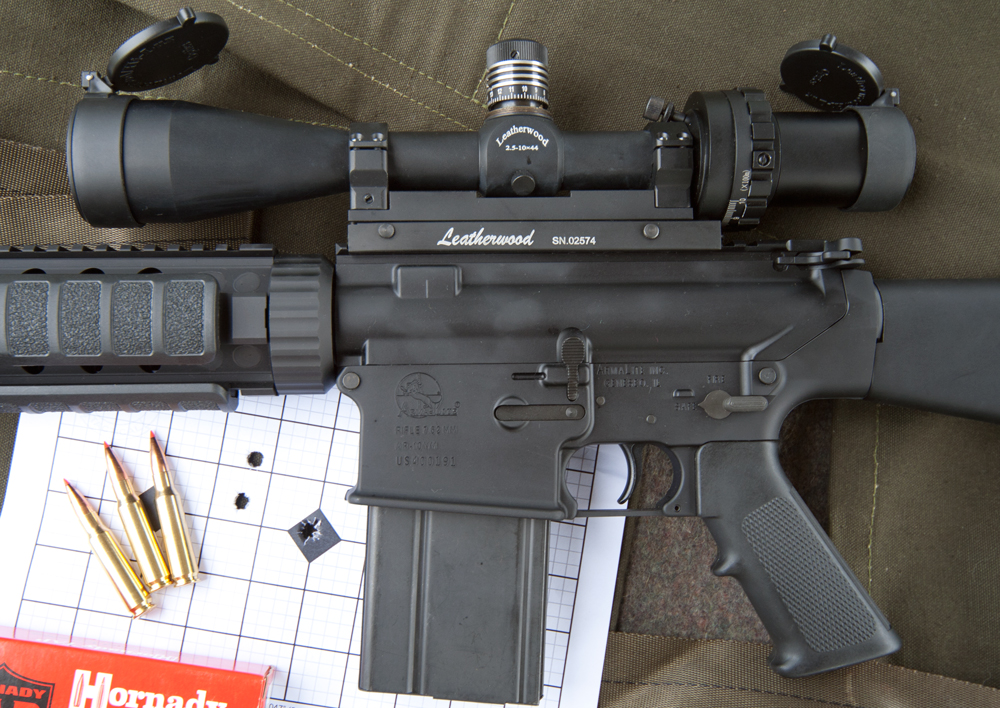
Setting Up the ART M1000 Sniper Scope
To test out the Leatherwood ART M1000 scope, I mounted it on the Armalite AR-10 NM (National Match) rifle. The ammo was Hornady TAP in .308 Win. (168 gr.). That's all best quality stuff, so there was no reason the rig shouldn't shoot — and shoot well.
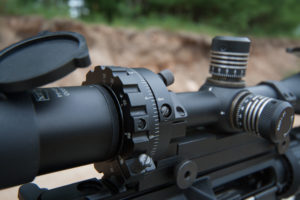 To mount the sniper scope, use the two large knurled thumbscrews to tighten the one-piece integrated base onto the Picatinny rail.
To mount the sniper scope, use the two large knurled thumbscrews to tighten the one-piece integrated base onto the Picatinny rail.
What I liked about this: It was fast and didn’t require any tools. What I didn’t like: After the first dozen or so shots you need to check and slightly retighten as the fasteners and lock washers settle in. However, the scope does ship with split washers and butterfly wingnuts for a more secure mount.
Calibrate Your Cam to the Ammo
Having done this, next step is to calibrate the cam to your chosen caliber and load. A table in the instructions makes it easy to find the correct load and indicates the corresponding code. For the 168 gr. .308 it was #420.
Loosenen the calibration ring and rotate it to line up with the arrow on the power ring. Re-tighten and you’re calibrated.
When you shoot at distance you can tweak this cam setting based on an actual flight performance of your load/gun in our environmental conditions.
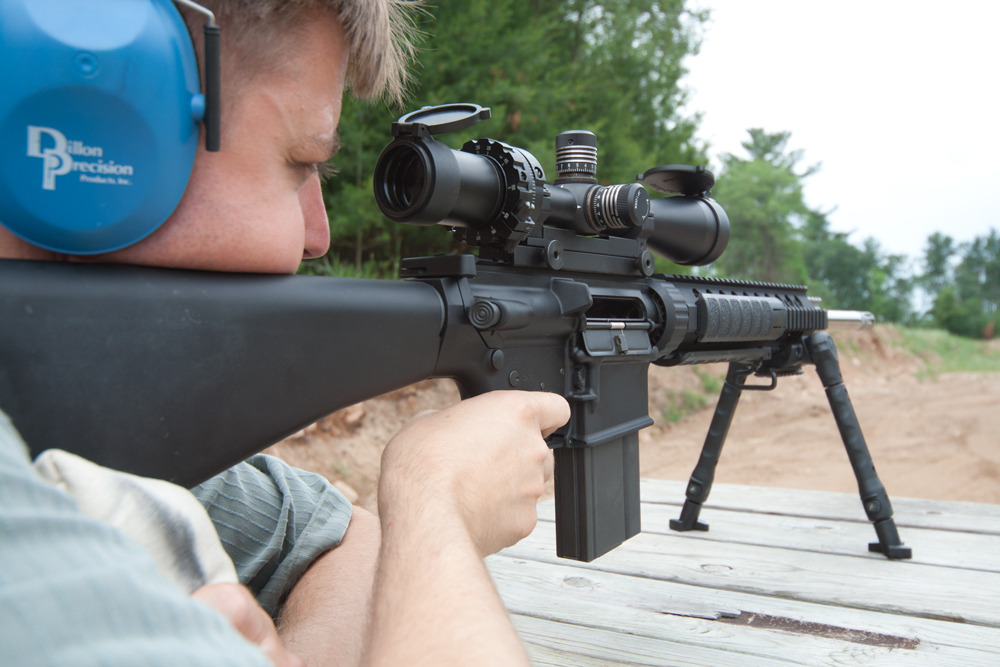
Sighting in the ART M1000
The power ring — which goes from 2.5X–10X — is married to the base via a cam. The result is a “no math” method of ranging targets makes sense in the heat of battle. You simply insert a target of known dimensions (18-inches or 1-meter) into a bracket on the reticle by turning the power ring.
Let’s say your 18-inch target is at long range but the distance is unknown. Next, looking through the reticle, you turn the power ring until the target fills half the bracket inside the reticle. After that, you can do two things: Swing the crosshair over to the target and shoot, or peek at the power ring to learn the distance (most critical for wind correction).
That means that when the target is at 250 yards or closer, you’ll be on 2.5 power. When the target is 500 yards, you’ll be on 5 power, 700 yards 7X, 800 yards 8X and 1000 yards 10x.
Leatherwood Scope Review
The first shot with the scope landed about 6 inches right and low. The ¼ MOA clicks on the turret were spot on and quickly brought the subsequent shots into the black. You zero the M1000 scope at 250 yards. Not having that much real estate at the range I was using, the instructions suggest using the top hash mark above the crosshair for a 100-yard sight-in, which should put me on at 250.
On the early generation scope I tested, the crosshairs were too thick. At 100 yards shooting on 2.5 power the width of a crosshair was about 1 MOA. I was able to shoot a 1.75 MOA group at that range, which is about as good as I could do with thick wires. However, the new Pro generation of M1000 scopes has a new HR1 reticle, which is much improved.
You can shoot the sniper scope in “manual mode,” where you unlock the power ring from the cam. In this mode you could shoot with the scope on 10X, which would help with precision. The downside is that you lose the auto ranging capability, which is sort of the point of this scope.
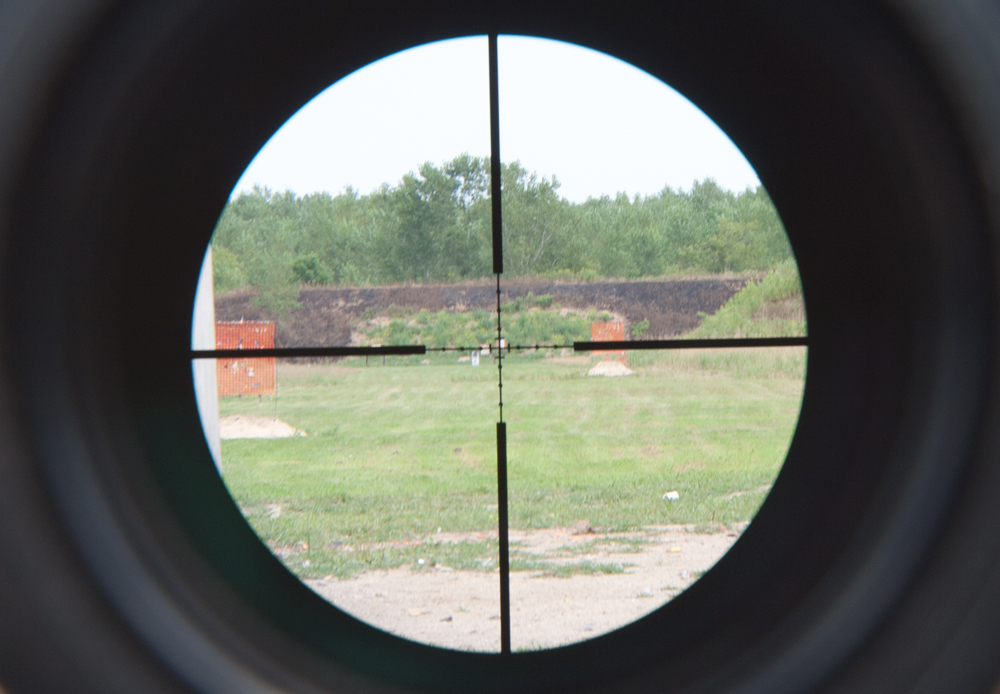
Shooting the Leatherwood ART Scope
 The Leatherwood M1000 ART scope's delineation is in meters, not yards. I first established that the rifle was hitting dead center at a 250-meter zero, with the power ring down on 2.5. Even though I had followed the suggestions in the instructions to start with a 100-meter zero by using the top bracket subtend in the reticle, my shots were actually about 6 inches high at 250. A quick adjustment corrected the issue.
The Leatherwood M1000 ART scope's delineation is in meters, not yards. I first established that the rifle was hitting dead center at a 250-meter zero, with the power ring down on 2.5. Even though I had followed the suggestions in the instructions to start with a 100-meter zero by using the top bracket subtend in the reticle, my shots were actually about 6 inches high at 250. A quick adjustment corrected the issue.
Now, one of the advantages of the Leatherwood ART scope — why the optic was so effective for Army snipers fighting in Vietnam — is the fact that you don’t have to know the range.
You only need to bracket a target of known dimensions by zooming in or out with the power ring. And then you shoot.
Scope that Automatically Adjusts
I placed the target at 400 meters to test the scope’s cam. Next, I zoomed in until the 18-inch target fit in half of the reticle bracket (see photo). Then I peeked at the power ring to verify. Sure enough, 4 power … and 400 meters — right on the money.
I took a five-shot string and assessed the target — a nice dead center group.
Impressed, I moved the target back to 550 meters. Rebracketed the 18-inch tall white piece of paper. Verify — 550 meters on 5.5 power.
The 5-shot string landed about 8 inches low, since I'd neglected to compensate the .5 mils for wind. As a result, shots landed left of the target in about a 7-inch group.
All would have “rung the gong” had I been shooting at steel.
The limiting factor with the scope is the thickness of the reticle. Out beyond 400 yards it took some doing to bracket the target precisely in the center of the thicker crosshairs to get an accurate reading and cam adjustment on the scope. Very doable, but it took some practice.
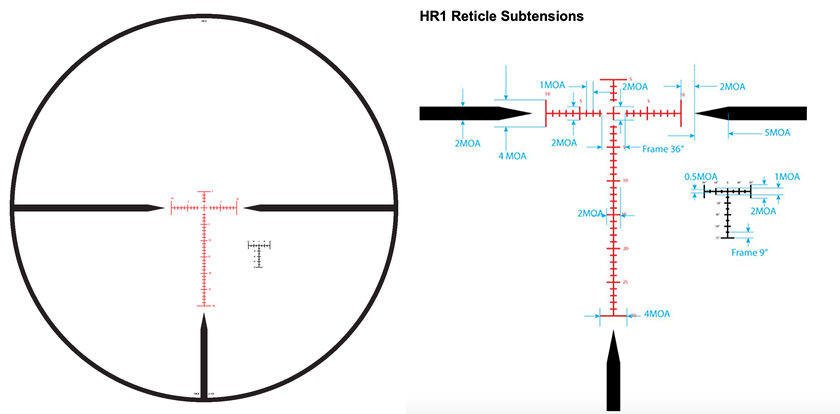
Leatherwood ART Scope Pro Update
The newest generation of the Leatherwood auto ranging scope is the M1000 Pro, which features an improved HR1 reticle with finer crosshairs and extremely precise subtensions for ranging. In fact, the new reticle also sports a small ranging scale (lower right of the reticle) to frame and range targets of known sizes from 9 to 72 inches in length or height.
And best of all, the new reticle is now illuminated, in your choice of red or green.
Other updates include:
- Optical System – 5 Ratio – 2-10x instead of 2.5 to 10x
- Updated Cam – more calibers accommodated
- Turrets are now MOA Tactical Turrets, no longer the tall multi-dial
- Lower Profile and compact
- Mounting base is stronger – 1 piece machined
- Thumb screws are upgraded – heavy duty
- Upgraded glass
- Illuminated, MOA Ranging Reticle
- Upgraded External Windage Adjustment – easier to use
Conclusion
The Leatherwood ART M1000 Pro sniper scope lives up to its claims. It gets you on target fast, with no calculations. With a retail price of around $500, this scope can make any shooter effective at virtually any distance — even me.
Users of high-end mil/mil tactical scopes might say the ART M1000 is not a precision accuracy scope. However, while that may have been true with the early generation scopes, it's no longer the case.
After having used the Leatherwood ART scope, it’s plain to see why the Viet Cong so feared Jim Leatherwood’s original design. It allowed our soldiers to frame, aim and shoot — without any complex mathematical or ballistic calculations — in the heat of battle under the most extreme stress.
Necessity truly is the mother of invention.
Hot Buy: Leatherwood M1000-Pro Auto Ranging Scope 2-10×42
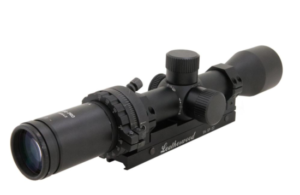 The Leatherwood M1000-Pro Auto Ranging Scope allows you to frame, aim and shoot to 1,000 yards and beyond with minimal calculations. Your eye never leaves the scope! Buy Here (Best Deal on the Internet!)
The Leatherwood M1000-Pro Auto Ranging Scope allows you to frame, aim and shoot to 1,000 yards and beyond with minimal calculations. Your eye never leaves the scope! Buy Here (Best Deal on the Internet!)
Click here to watch a video and download a free Users' Guide

Next Step: Get your FREE Printable Target Pack
Enhance your shooting precision with our 62 MOA Targets, perfect for rifles and handguns. Crafted in collaboration with Storm Tactical for accuracy and versatility.
Subscribe to the Gun Digest email newsletter and get your downloadable target pack sent straight to your inbox. Stay updated with the latest firearms info in the industry.


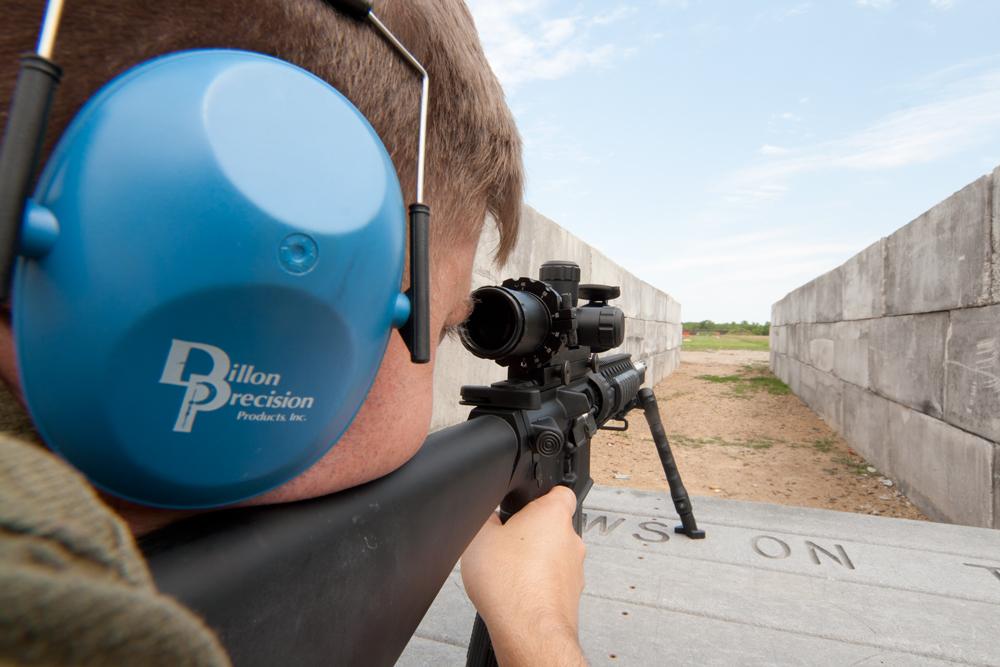
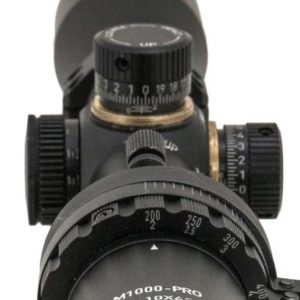
![Best Concealed Carry Guns In 2025 [Field Tested] Wilson Combat EDC X9S 1](https://gundigest.com/wp-content/uploads/Wilson-Combat-EDC-X9S-1-324x160.jpg)


![Best 9mm Carbine: Affordable PCCs [Tested] Ruger Carbine Shooting](https://gundigest.com/wp-content/uploads/Ruger-Carbine-Shooting-100x70.jpg)
![Best AR-15: Top Options Available Today [Field Tested] Harrington and Richardson PSA XM177E2 feature](https://gundigest.com/wp-content/uploads/Harrington-and-Richardson-PSA-XM177E2-feature-100x70.jpg)

My precision bolt gun in Nam had a 10X fixed power scope by Unertl. It had a fast to use reticle and excellent glass.
I have an inherherited Leatherwood, Outdoors Hi-Lux scope. to to3.5-10×50 body and3.5-10×50 on lens. Is it possible to purchase a set of instructions for thi
I have a Leatherwood M-1000,2.5x10x44. Nowhere do I see ART on the scope. What model do I have. It’s probably not what I thought I was buying. Was wondering how ranging & bullet drop was automatically achieved
I would rather invest a little more money for a scope not made in Communist China. Just saying.
Corbitt Leatherwood contacted me with an offer to help. He did send some supplemental information which I think might be on his site. Again, I am not displeased with the scope but setup was not intuitive. One person offered to purchase it from me, he’s probable smarter than I, but I turned it down. So, anyway, with Corbitts patience and my fingers I am sure I’ll get it together. A nice feature is I can set it up for a 5.56×45 and a 7.62×51.
Have had an M-1200 for several years. Optics are of mediocre quality and the ranging nob is tight but it does what it says it does. I have shot 1000 yards with it and usually hit within 3 feet on the first attempt, secondary adjustment brings it much closer. Definitely a great concept, but on a cheap overseas scope.
I purchased a M-1000 because of Viet Nam. It was to go on a M-4. For the life of me I could not figure out how to calibrate it. It has a small owner’s manual, it is not the one I would have written, for me it did not cover the scope point by point. Do this, then do this, then do this. Leatherwood contacted my by e-mail once to see how I liked it. I don’t know how I like it because as far as I could tell I couldn’t set it up. Nice scope, good optics, like the way it mounts, it sits in a drawer. Must be me because other people like it fine. Still sits in a drawer. If someone, anyone could help me out, well that would be nice. [email protected]